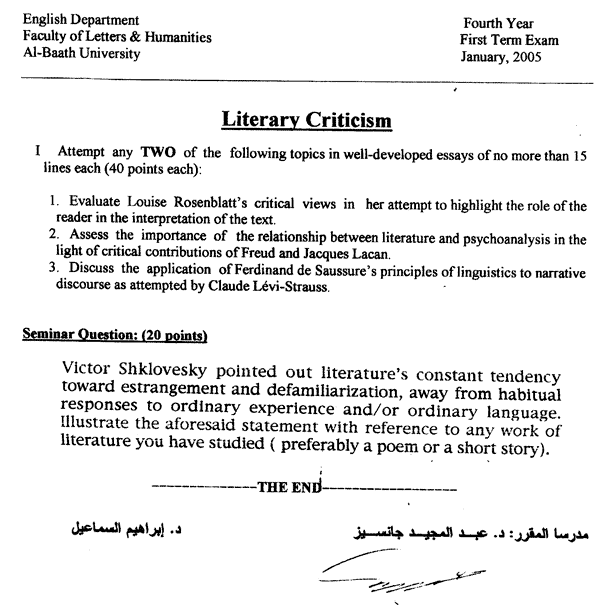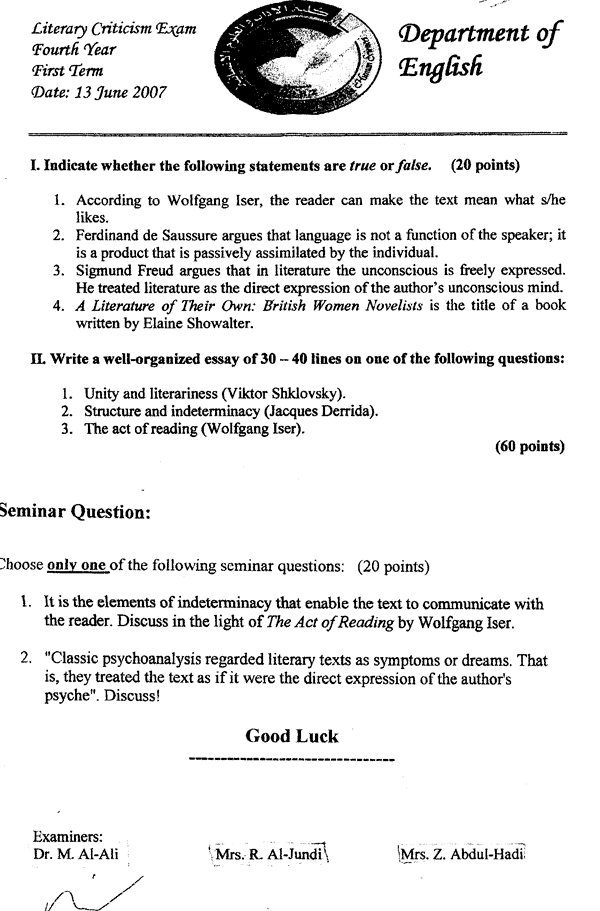مشرف موسوعة الأدب الانجليزي
 |
|
اشترك في: الاثنين ديسمبر 17, 2007 3:47 am
|
|
مشاركات: 1898
|
|
القسم: Literature, Film, and Theatre
|
|
السنة: MA
|
|
مكان: Britain
|
|
دورة الفصل الثاني للعام الدراسي 2008-2009
Answer the questions below by choosing one answer (A, B, C or D) to each question (fill in the box that corresponds to the letter of the answer you have chosen on your answer sheet). (2 points for each question)
1. A new version of the Battle of the Books between the Ancients and the Moderns has been raging in recent years: the former complain that the Moderns behave as if literary theory never existed before A. Barthes and Saussure B. Barthes and Jakobson C. Barthes and Derrida D. Barthes and Iser reared their brazen heads.
2. The Moderns appear to regard traditional critics as prehistoric moles working in the dark before the dawn of A. formalism, structuralism and semiotics B. structuralism, semiotics and deconstruction C. semiotics, deconstruction and subjective criticism D. deconstruction, subjective criticism and psychoanalytic theory.
3. It's been suggested that the methods and assumptions adopted by critics merely reflect their interests or their 'will to power'. This view, according to Raman Selden, is A. logocentric B. unrealistic C. Romantic D. None of the above.
4. According to Raman Selden, we may interpret the existence of different critical traditions as A. an endlessly fascinating struggle for supremacy B. an endlessly fascinating struggle for supremacy or a series of attempts to establish a knowledge of the literary process C. an endlessly fascinating struggle for supremacy or a series of attempts to establish a knowledge of the role of the reader in the circuit of communication D. an attempt to provide a scientific account of literature.
5. One of the following questions is not included in the set of fundamental questions we usually raise about literature and its contexts—which one? A. Can critical analysis, interpretation or reading avoid implicit theory? B. What are the formal and structural properties of texts? C. Is literature a part of history D. What mental processes, whether the writer's or the reader's, contribute to the production of literary texts?
6. Affective criticism A. is based on the rhetorical view that emotional effects can be produced only by piling up phrase upon phrase B. emphasizes the necessity of piling up phrase upon phrase, but it also recognizes the plain sublime, in which simple words can stir deep emotions in the reader C. emphasizes the necessity of piling up phrase upon phrase, but it also recognizes the silent or plain sublime, in which simple words or even total silence can stir deep emotions in the reader D. places all emphasis on expressing emotions, regardless of what these emotions are or what the language (style, form, etc) used is.
7. Wordsworth A. establishes a clear-cut dichotomy between poetry as emotional knowledge and science as intellectual knowledge B. resists the temptation to establish a clear-cut dichotomy between poetry as emotional knowledge and science as intellectual knowledge C. He does not say anything about this point D. insists on confining poetry to verifiable and factual statements about the psychological benefits of the excitement of feelings.
8. The sublimity of poetry, according to Romantics, rests essentially on A. emotional power B. the greatness of thought C. A & B D. emotional power, the greatness of thought and the expression of personal experience.
9. William Wordsworth argues that A. the understanding of the reader must be enlightened B. his affections must be strengthened C. his affections must be strengthened and purified D. all of the above.
10. He also argues that poetry takes its origin from A. personal experience B. laws and customs C. divine inspiration or the contemplation of the goings-on of the universe D. emotion recollected in tranquility.
11. According to Reader-Response critics, the reader A. can make the text mean what s/he likes B. cannot make the text mean what s/he likes C. That depends on linguistic knowledge D. That depends on the reader's activity of reading.
12. Reader-Response critics focus on the reception of the text A. in the present only B. in both the past and the present C. That depends on the issues the text tackles D. That depends on the historical references the text displays.
13. According to Wolfgang Iser, the concept of the implied reader is a A. social structure B. textual structure C. psychological concept D. A, B, & C.
14. Iser argues that the reader's communication with the text is a process of A. self-correction B. self-inspection C. self-production D. self-destruction.
15. He also argues that fictional texts A. constitute their own objects B. copy something already in existence C. usually constitute their own objects, but sometimes they copy something already in existence D. sometimes constitute their own objects, but in most cases they copy something already in existence.
16. Western though has often recognized that the rational part of the human mind is in A. correlation B. connection C. contention D. conjunction with passion and imagination.
17. According to Freud, our drives A. cannot express themselves at all B. can express themselves in indirect forms C. can express themselves freely and directly. D. can express themselves only in writing.
18. 'Neurosis' means A. excessive violence B. Psychic drive or energy, especially that which is associated with the sexual instinct C. loss of memory D. none of the above.
19. The libido, Freud argues, needs to be discharged A. to ensure pleasure B. to prevent pain C. to ensure pleasure and prevent pain D. to get rid of fantasies.
20. Freud attributes the Oedipus complex to children of about the ages A. two to five B. two to ten C. three to five D. three to ten.
21. The term 'Oedipus Complex' was originally applied to boys; the equivalent in girls is called A. Electra Complex B. Electral Complex C. Elentra Complex D. Elentral Complex
22. Which part of the mind acts as a censor on wishes? A. the ego B. the superego C. the id.
23. In the present, the concept of unity is considered A. realistic B. pragmatic C. axiomatic D. problematic.
24. The belief in the 'unity' of literary texts is a hangover from our A. Romantic inheritance B. New Critical inheritance C. Romantic and New Critical inheritance D. none of the above.
25. For Formalists, attention should be focused on the words on the page as A. a self-sufficient entity B. expressions of a universal human experience C. expressions of the ironic D. expressions of a specific social message.
26. Formalists believe that A. the elaboration of devices is subordinated to content B. content is subordinated to the elaboration of devices C. formal devices and content are of equal importance D. the elaboration of devices is important in poetry only.
27. They also "believe that we can develop a properly rigorous and objective analysis of a text only by A. isolating that text from its author B. isolating that text from its context C. isolating that text from its author and context D. studying the ways in which the text absorbs biography, history, language, and so on, into its structure.
28. The purpose of art, according to Shklovsky, is to impart the sensation of things A. as they are known B. as they should be C. as they are perceived D. A, B & C.
29. The technique of art, Shklovsky argues, is A. to make objects unfamiliar B. to make forms difficult C. to increase the difficulty of length of perception D. A, B & C.
30. Saussure argues that in order to isolate a linguistic system it is necessary to A. cut a synchronic slice from the diachronic flow of language B. cut a diachronic slice from the synchronic flow of language.
31. Saussure notes that the relationship between the signifier and the signified is arbitrary. This means that it is A. natural B. inevitable C. not based on a natural or necessary reason D. subjective.
32. The signifier, according to Saussure, A. has one, permanent signified B. always has more than one signified C. can have more than one signified D. can have a limitless number of signifieds.
33. The sign is a two-sided A. social entity B. linguistic entity C. historical entity D. none of the above.
34. Structuralists treat signification as A. an unstable and unsystematic process B. a stable and systematic process.
35. According to Saussure, A. linguistics is a part of semiology B. semiology is a part of linguistics.
36. According to Derrida, we A. can B. cannot break free from the conceptual universe we inherit.
37. 'Differance' alludes to A. spatial differences B. temporal deferment C. A & B. D. neither spatial differences nor temporal deferment.
38. The distinction between signifier and signified, according to Derrida, remains within the heritage of A. logocentrism B. phonocentrism C. A&B. D. None of the above.
39. A. Elaine Showalter B. Kate Millett C. Helene Cixous D. Simone de Beauvoir examines the writings of British women novelists since the Brontes.
40. 'Gynocriticism' deals with A. the distinctive themes, structure and genres of women's writings B. the nature of female creativity and female language, and the historical problems facing women as writers C. the distinctive themes, structure and genres of women's writings, the nature of female creativity and female language, and the historical problems facing women as writers D. the distinctive themes, structure and genres of women's writings, the nature of female creativity and female language, and the historical problems facing women in capitalist societies. الدكتور محمد رياض العلي
-------------------------------------------------------------
_________________
[english][align=center]"We are the choices we have made."[/align][/english]
|
|















